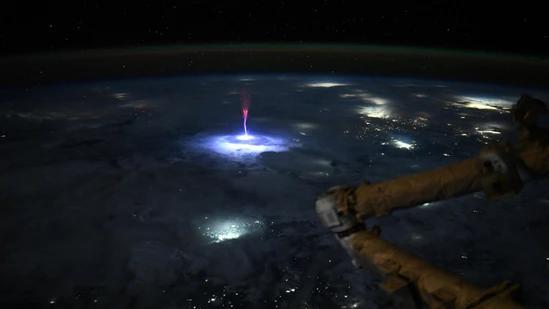
NASA Astronaut Captures Rare ‘Sprite’ Lightning Over US & Mexico
In a breathtaking moment, NASA astronaut Nichole Ayers captured a rare and fascinating atmospheric phenomenon known as ‘sprite’ while orbiting above the United States and Mexico from the International Space Station. The stunning image has left scientists and space enthusiasts alike in awe, offering a unique glimpse into the intricacies of our planet’s weather systems.
Ayers, a seasoned astronaut with multiple missions under her belt, shared the remarkable photo on social media, which showcases a vibrant, glowing phenomenon hovering above a thunderstorm. The image quickly went viral, with many marveling at the sheer beauty and rarity of the spectacle.
So, what exactly is a ‘sprite’? These Transient Luminous Events (TLEs) are brief bursts of light that occur above thunderstorms, typically at altitudes of around 50-100 kilometers (31-62 miles) above the Earth’s surface. They are a type of electrical discharge that takes place when a thunderstorm’s strong electric fields interact with the ionosphere, a layer of the atmosphere that extends from about 50 to 600 kilometers (31 to 373 miles) above the Earth’s surface.
Sprites are relatively rare, but they have been documented in various parts of the world, including the United States, Mexico, and other regions prone to thunderstorms. Ayers’ capture of this phenomenon from the International Space Station offers a unique perspective, allowing scientists to study the relationship between sprites and thunderstorms in greater detail.
“It’s a very rare event, and we’re thrilled to have captured it,” Ayers said in a statement. “Scientists can use these types of photos to better understand the relationship of TLEs to thunderstorms, which is an important area of research.”
The International Space Station, orbiting some 250 miles (400 kilometers) above the Earth’s surface, provides a unique vantage point for studying atmospheric phenomena like sprites. Astronauts on board the station can capture high-resolution images of these events, which can then be analyzed by scientists to better understand the underlying physics.
Sprites are of significant interest to scientists because they can provide valuable insights into the complex interactions between thunderstorms, the ionosphere, and the Earth’s magnetic field. By studying these events, researchers can gain a better understanding of the electrical discharges that occur during thunderstorms, which can help improve predictive models for severe weather events.
In addition to their scientific significance, sprites are also a testament to the awe-inspiring beauty of our planet’s weather systems. The International Space Station has provided a new perspective on the Earth’s atmosphere, allowing astronauts and scientists to capture stunning images of atmospheric phenomena that would be impossible to observe from the ground.
Ayers’ capture of the sprite is a perfect example of the incredible opportunities that the International Space Station provides for scientific research and exploration. As we continue to push the boundaries of space exploration, we are reminded of the importance of continued investment in space research and the incredible discoveries that await us.






